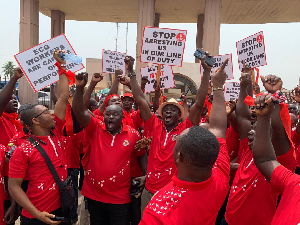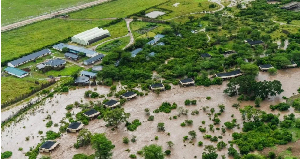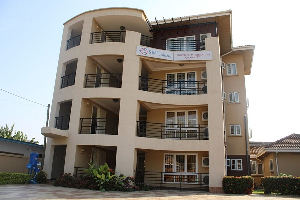- Home - News
- TWI News | TV
- Polls
- Year In Review
- News Archive
- Crime & Punishment
- Politics
- Regional
- Editorial
- Health
- Ghanaians Abroad
- Tabloid
- Africa
- Religion
- Election 2020
- Coronavirus
- News Videos | TV
- Photo Archives
- News Headlines
- Press Release
Opinions of Wednesday, 29 October 2003
Columnist: Public Agenda
Threat of a big earthquake looms - But are we ready?
Disasters are as old as the existence of man on earth. It is impossible to stop the natural ones from occurring. As we know disasters affect human beings, therefore, where there is no human habitation there can be no disaster even if there is an occurrence of flood or earthquake on the uninhabited desert or ocean. Thus as the human population increases scales of disasters also must increase and that is what we are seeing in the world today.
Disaster types
There are several disaster types and these are grouped according to agency, into hydro-meteorological, fires and lightning, pests and insects infestation, disease epidemics, geological and man-made disasters.Ghana has suffered from each of these disasters and still stands to suffer from them. Most of the mentioned disasters are natural, but human activities sometimes trigger their occurrence and aggravate their impacts. Putting a building on a water course for instance may also cause flooding even with a moderate rainfall.
Several attempts have been made over the years to counter or minimize the effects of disasters. These include event prediction, prevention and mitigation measures. Sophisticated devices have been invented in this direction. For example, there are instruments that help predict the weather and warn us against possible windstorm or heavy downpour that could cause flooding. There are seismographs that detect and record movements in the earth, which can be used to prepare Seismic Hazard Maps to assist engineers design safer buildings. There are also devices used in detecting smoke and fires to help check or prevent them from degenerating into fire disaster.
Earthquake risk and vulnerability:
Ghana has had its fair share of earthquakes. There have been damaging earthquakes in 1615, 1636, 1862, 1906 and 1939. It was recorded, for example, that in 1615 an earthquake destroyed what was then known as Takoradi; in 1636, an earthquake occurred in Axim and the whole of the East Nzema was badly shaken. It caused a widespread collapse of buildings in that area. A gold mine in Aboasi, northeast of Axim was reported to have collapsed, burying many of the miners (after Quaah, 1997).Although Ghana cannot be said to be earthquake prone like Japan or Turkey, the seismic microzonation done for country after the 1939 earthquake and other historical records show that the southern part of the country could suffer a major earthquake in the very near future.
Historical records and repeated tremors being experienced in Accra and its environs heighten our fear of occurrence of a damaging earthquake in this part of the country. And, the danger is that not all active faults in the country have been clearly located and mapped. Knowing exact locations of seismic faults and monitoring them will help scientists and engineers to prepare a Seismic Hazard Map. This map will help them give advice to prospective developers and also make appropriate designs that can “resist” high level of ground shaking. Lifeline structures such as schools, hospitals could be sited away from zones of high seismic risk, with the help of such a map. The Geological Survey Department of Ghana and the universities need adequate resources to undertake this urgent and specialised assignment of earthquake hazard mapping and zoning of structures to prevent earthquake disasters.
Most houses in the country are owner-built with little or no engineering at all. The building materials used especially in the rural areas are mud bricks, or sun-dried bricks with mud patching. These buildings put their inhabitants to great risks in the event of an earthquake. Owner-built houses in the cities can also not escape devastations of earthquake. The situation where landlords virtually scratch the ground surface of empty spaces in their homes and hurriedly put up rooms for rental to desperate tenants exposes the society to great dangers of earthquake disasters. People living in ‘landfilled’ areas are also equally at great risk.
It is very important that urgent steps are taken by the local government agencies to ensure that laws governing the putting up of buildings, and the appropriate materials to be used in building and construction are strictly complied with.
Exits:
Emergency exit is one important aspect of our buildings that have been taken for granted.It is very necessary that exits to all public buildings including commercial houses, schools, churches, mosques and offices more than one, and are made wide enough to allow for people to rush out with the least impediments. The May 9, 2001 tragedy at the Accra Sports Stadium should remind us all of the importance of adequate exits especially in times of emergency.
Even where enough emergency exits it is not uncommon to find than closed or permanently locked or blocked.
Other frightening example of narrow and insufficient exits are those found in the Annex buildings of the University of Ghana and storey buildings in several institutions of learning Each block of the Annexes has five floors with sixteen rooms per floor. Every room has, at least, four occupants meaning there can be about three hundred and fifty occupants in one block. If there should be a fire outbreak or earthquake we can all guess the stampede that can occur at these single and narrow exits.
We may also have to take a second look at some public elementary schools where windows are being replaced by decorative blocks, and doors are partly shut while lessons are on-going. Similarly, private school buildings with crowded classrooms with only one door are death traps. Can you imagine what could happen in such a classroom if a snake meanders in or there is a fire outbreak?
Safe havens
In every well-planned town or community some areas are intentionally left open for recreation and public gathering. These open spaces serve also as safe havens or safe places of gathering in times of emergency. Tents can be pitched quickly to temporarily house victims of disasters.In Accra, and other urban areas these open spaces are gradually being encroached upon or re-zoned for other purposes.
For instance, the busiest part of Accra Central has no open space. Accessibility to busy Rawlings Park in times of emergency during business hours could be disastrous. The National Theatre now occupies the open space that used to be the training grounds of Accra Great Olympics. It is believed that the space near the Novotel Hotel, which is the only one near Tudu and Lorry Park, will soon be filled. The list goes on and on.
Human and economic losses:
In 1923 an earthquake occurred in Tokyo, Japan and claimed over 142,000 lives. About 87 per cent of the deaths were caused by fire that followed the event. The death toll could have been drastically reduced if there were open spaces closer to residential areas where victims could run to for safety. Japan learnt its lessons well and now public parks and gardens abound in every town and city in that country with streets made consciously to serve as fire belts. The open spaces are not wasted land: they are places of safety in times of emergencies. And our chiefs, town and country planners and the District/Municipal and Metropolitan authorities should take a cue to rectify the mess. Ghana cannot afford to lose the precious lives of its citizens. Sadness that gripped us all on few tragedies that occurred in the past clearly shows that we don’t welcome tragedies and disasters. We all remember the chills that went down our spines, and The nation was brought to a standstill when children drowned in an old abandoned and manhole while playing at school at Akoto Lante, Accra. We remember with shock the floods that claimed about 17 lives in Accra in1995. Never can we forget the tragic “Accra Sports Stadium Disaster” in 2001, in which we lost 126 people.
Are we ready for such losses? Are politicians, traditional rulers, the affluent and other influential citizens using their positions to get things done their way even if they put the larger community at risk? Some may argue that earthquakes may not occur now, but who knows? Even if this is true should we forget about fire and other disasters?
Let us learn from others and correct what we are not doing right immediately! In 1995 an earthquake struck Kobe in Japan. Before then the last time that city suffered from earthquake was over 600 years ago and we know the devastations it caused. Earthquakes and other disasters in general make no distinction between political and religious persuasions, social statuses, ethnicity and economic standing.
In Nepal an earthquake damaged the royal palace killing the king. How safe are our seat of government, the Castle, Parliament, and Ministries, Chiefs’ Palaces from earthquakes and other disasters?
Remember the tragic earthquake in Algeria a few months ago in which 5,000 lives were lost. The magnitude was 6.7. A much larger earthquake of magnitude 8 on the Richter Scale occurred in September this year in Japan killing only five (5) and injuring about 300 people. Why was it so? Japan has over the years invested substantial resources engineered workable and enforced legislations that have made it a good example as an earthquake “resistant” nation.
Unfortunately, given the tectonic setting of Ghana and Africa in general, earthquakes that occur here are intra-plate and mostly shallow. This means its devastation could be very severe.
In 2001, a large earthquake (intra-plate) occurred in India. More than 13,000 people died, over 900,000 buildings were destroyed.
The human and economic losses, loss of important ecological system and cultural sites, and trauma that resulted from the disaster is simply immeasurable. We cannot but wish for such a catastrophe not to happen in Ghana. But mere wishes cannot influence natural forces. We can only avoid such tragedy if we start doing things right. We must avoid known faults. We must build using good materials and seeking advice from engineers and other specialists in building and construction. We simply need to act as responsible political office holders, individuals, corporate developers, communities and as a nation. Opinion leaders, traditional authorities and law and policy makers and enforcers must have disaster prevention and mitigation in mind while they formulate policies and enforce rules, to enhance development.
Failure to correct the mess to avoid a disaster could erode years of well-intended efforts to develop the nation. The 1995 Kobe (Japan) earthquake claimed about 6,400 lives. Economic losses were estimated to be US$8 billion. The GDP of that country that year was about US$550 billion. In percentage terms, the loss was about only 1.5 per cent of the GDP.
But if an earthquake of similar impact hammer Ghana what would be the economic loss to the state apart from the human losses?
NADMO and its collaborators in disaster management need all the necessary political and financial support, good planning, good legislation, law enforcement at both national and local levels, to reduce the nation’s vulnerability to disasters in general, and to earthquakes in particular.










